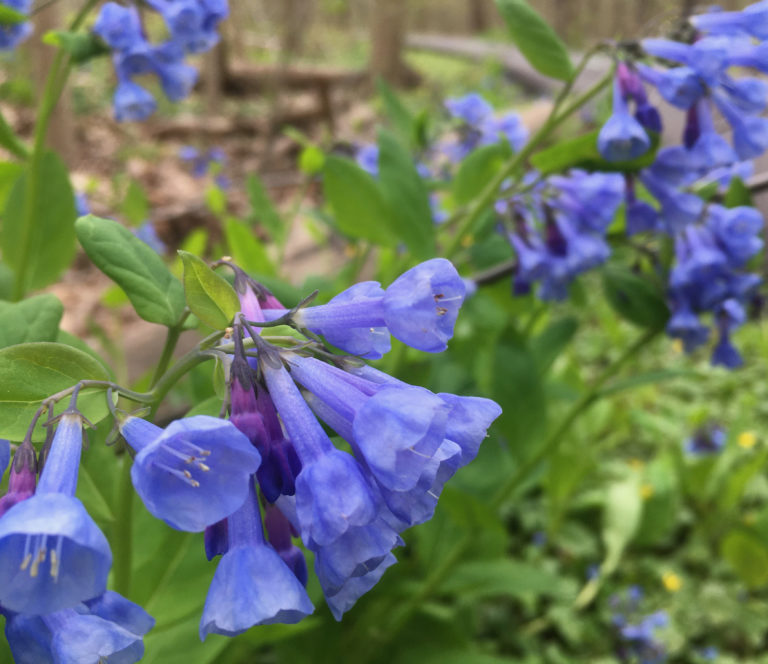Virginia Bluebells is a magical spring ephemerel plant, an absolute must for every garden with a spot of shade! It is an early spring riser with soft, floppy, grey-green, oval shaped leaves. The flower buds are pink, bluish pink or lavender as they uncoil near the top of each stem, then the wonderful nodding clusters of flowers open and fade to a light blue. The plant is about 2′ tall and 1′ wide. Virginia Bluebells prefers moist, rich soils in part to full shade. As warmer days approach the plant will quickly yellow and plunge into dormancy, resting until the next spring. Easy to grow by sowing fresh seed or dividing tubers in spring. Over time Virginia Bluebells will colonize. It is best to interplant with ferns, asters, Green & Golds — as the Bluebells fade, the other perennials with fill in the space as the season continues. Virginia Bluebells can do well planted under Black Walnut trees and it is also resistant to deer & rabbits.
NURSERY HOURS
Wednesday: 10-4 Thursday: 10-6 Friday-Saturday: 10-4 Sunday: 12-4
Mertensia virginica

Key Info
Scientific Name: Mertensia virginica (L.) Pers. ex Link
Common Names: Virginia Bluebells, Virginia Cowslip, Mertensia, Eastern Bluebells, lungwort oysterleaf
Family Names: Boraginaceae
Plant Type: Herbaceous perennial
Moisture Requirement: Moist well drained
Leaf Retention: Deciduous
Flower Color: Pink changing to light blue
Additional Info
Habit: Upright stem, occasionally branched; will colonize over time.
Height: 2'
Spread: 1'
Soil Conditions: Easily grown in average, medium, well-drained soils, but prefers moist, rich, well-drained soil. pH-Circumneutral (pH 6.8-7.2)
Leaves: Perennial, alternate leaves up to 7" long and 3 1/2" across. They are grey green oval shaped leaves all along the stem, with a soft, floppy texture.
Flowers (or reproductive structures: Nodding clusters of pink buds that open into light blue trumpet-shaped flowers. Individual flowers are about ¾–1¼" in length. The corolla of each flower is tubular at its base, but it is more bell-shaped (campanulate) toward its outer rim, where there are 5 shallow lobes that are barely discernible. Inserted within the corolla, there are 5 white stamens with light brown anthers and a white style that is long and slender. The small greyish green calyx of each flower is about ¼" (6 mm.) long; it is divided into 5 elliptic teeth. The flower buds are pink, bluish pink, or purple, while the corollas of mature flowers are light blue (rarely white or pink). The pedicels of the flowers are greyish green to purple, terete, and up to ¼" (6 mm.) long. The blooming period occurs from mid- to late spring, lasting about 3 weeks.
Fruit: The flowers are replaced by 4-lobed fruits (schizocarps), which contain the nutlets (4 nutlets per flower). The small nutlets are dark brown, ovoid, and flattened on one side; their surfaces are minutely wrinkled or pitted.
Natural Distribution: River bottoms, moist clearing and woods
USDA Hardiness Zone: 3 to 8
USDA Wetland Indicator Status in NC: FACW (Piedmont) and FAC (Coastal plain)
Pollination: The flowers are cross-pollinated by long-tongued bees primarily, including honeybees, bumblebees, Anthophorid bees, and mason bees; these insects obtain nectar and/or collect pollen. Also collecting nectar from the flowers: the Giant Bee Fly, butterflies, skippers, and Sphinx moths, including a hummingbird moth (Illinoiswildflowers.info).
Wildlife Connections: Ruby-throated Hummingbird has been observed to visit the flowers. White-Tailed Deer browse on the foliage occasionally during the spring. When this plant forms large colonies, it provides protective cover for many kinds of wildlife during the spring. (Illinoiswildflowers.info)
Propagation: easily propagated by sowing fresh seed or dividing plants in spring
